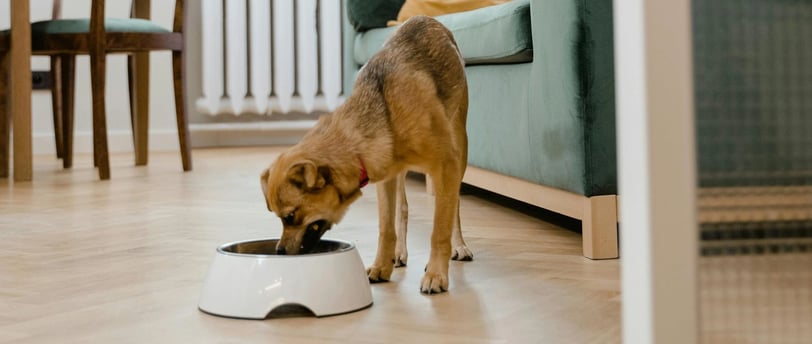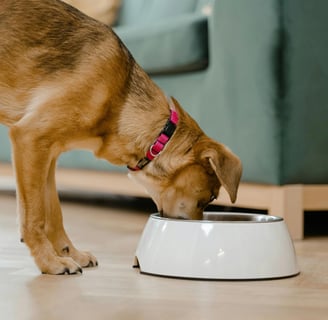Why Doesn't My Dog Want to Eat Kibble?
Kibble is a practical and economical option for feeding your dog, but what should you do if they refuse to eat it? In this article, we explore the reasons why your dog may refuse kibble, whether it's due to health issues, food preferences, or an incorrect transition. We also provide practical tips to make kibble more appealing and tell you when it's necessary to visit the vet. Don't miss this complete guide to resolving kibble rejection and ensuring a healthy diet for your furry friend!
NUTRITION


Kibble is one of the most popular feeding options for dogs due to its convenience, ease of storage, long shelf life, and cost-effectiveness. It is formulated to meet the nutritional needs of dogs based on their age, size, activity level, and health condition. However, while most dogs accept kibble without issues, some may refuse it or have difficulty adapting to this type of diet. If your dog doesn't want to eat kibble, don't worry, as there are multiple reasons that may explain this behavior and solutions to address it.
In this article, we will explore the most common reasons why a dog may refuse kibble, whether it's a puppy or an adult, and provide practical tips to help resolve the situation. Additionally, we'll discuss when it's necessary to visit the vet.
Why Won't My Puppy Eat Kibble?
Puppies should be exclusively fed mother’s milk during the first few weeks of life, as it provides essential nutrients and antibodies to strengthen their immune system. Additionally, staying with their mother and siblings for at least eight weeks is crucial for their social and emotional development. Starting at 4-5 weeks, solid foods such as puppy kibble can be introduced, but this process should be gradual and careful.
Common Reasons for Kibble Refusal in Puppies:
Abrupt transition from milk to kibble: If kibble is introduced suddenly, the puppy may reject it. The transition should be gradual by mixing wet kibble with warm water or unsalted broth to ease the adjustment.
Inappropriate texture: Puppies may not be ready to chew dry kibble. Soaking the kibble or choosing a specific puppy kibble with a softer texture can help.
Premature separation from mother: If the puppy was separated from its mother before 8 weeks, it may not have learned how to properly eat solid foods.
Tips for a Smooth Transition:
Offer soaked kibble in small amounts.
Mix the kibble with a little puppy formula (never cow’s milk, as it may cause digestive issues).
Make sure the kibble is high-quality and formulated specifically for puppies.
Why Won't My Adult Dog Eat Kibble?
In adult dogs, refusal to eat kibble can stem from various physical and behavioral causes. It's essential to rule out health issues before assuming it's just a matter of preference.
Common Causes for Kibble Refusal in Adults:
Health problems: Dental issues, stomach pain, infections, or chronic conditions can cause a loss of appetite. If your dog stops eating suddenly, it’s vital to consult a veterinarian.
Poor-quality kibble: Low-quality kibble may be unappetizing or even cause digestive discomfort. Choose kibble with high-quality ingredients tailored to your dog’s needs.
Abrupt diet changes: If you've recently switched kibble brands or types, your dog may need time to adjust. Introduce the new kibble gradually by mixing it with the old one.
Mixed diet: If your dog frequently receives homemade food or treats, it may prefer these over kibble, leading to nutritional imbalances if not managed properly.
Stress or anxiety: Environmental changes, routines, or the presence of other animals can affect your dog’s appetite.
What to Do if My Dog Won’t Eat Kibble?
If your dog is healthy but refusing kibble, you can try the following strategies:
Introduce kibble gradually: Mix the new kibble with the old one in increasing proportions over several days.
Choose high-quality kibble: Check the ingredients and ensure it’s suitable for your dog’s age, size, and activity level.
Establish a feeding routine: Dogs are creatures of habit. Feed at the same time every day and remove the food after 15-20 minutes, even if they haven’t eaten.
Avoid giving other foods: If your dog knows it can get homemade food or treats, it’s likely to reject kibble.
Make the kibble more appealing: Soak it with warm water or unsalted broth, or add some wet dog food.
What to Mix with My Dog’s Kibble?
If your dog needs an extra incentive to eat kibble, you can try the following options:
Soak the kibble: Add warm water or unsalted meat broth to soften it and enhance its aroma.
Add natural supplements: Some dogs enjoy mashed pumpkin, cooked carrots, or a little coconut oil.
Use specific toppings: Products like Barkyn flavors, made with natural ingredients, can make kibble more appetizing.
When to Visit the Vet if My Dog Won’t Eat?
Lack of appetite may be a sign of underlying health issues. You should visit the vet if:
Your dog hasn't eaten for more than 24-48 hours.
It shows other symptoms such as vomiting, diarrhea, lethargy, or weight loss.
It's a puppy, senior dog, or has a pre-existing medical condition.
You suspect the refusal to eat is related to a dental or digestive problem.
Alternatives to Kibble: Are They a Good Option?
If your dog persistently refuses kibble, you may consider other feeding options. Some alternatives include:
BARF Diet (Biologically Appropriate Raw Food): This diet involves raw foods such as meat, bones, organs, and vegetables. Consult with a vet specialized in nutrition to ensure the diet is balanced.
Homemade food: You can prepare meals for your dog, but they must be well-balanced to meet their nutritional needs. A veterinary nutritionist can help create a suitable plan.
Wet food: Canned wet food may be more appetizing for some dogs, though it tends to be more expensive and less convenient than kibble.
Fun Facts About Dog Feeding
Dogs have taste preferences: Unlike humans, dogs have fewer taste buds and prefer savory and meaty flavors. However, their sense of smell is highly developed, so the aroma of the food is crucial for their appetite.
The color of kibble doesn't matter: Dogs don’t perceive color the way we do, so the color of the kibble is irrelevant to them. What matters most is the smell and texture.
Hydration is key: Always ensure your dog has access to fresh water, especially if they’re eating dry kibble, as it contains very little moisture.
Conclusion Refusal to eat kibble can be caused by many factors, from health problems to food preferences. Identifying the cause is the first step toward solving the issue. If your dog is healthy, you can try different strategies to make the kibble more attractive. However, if you suspect something is wrong, don’t hesitate to consult your vet. Remember, proper nutrition is essential for your dog’s health and well-being.


